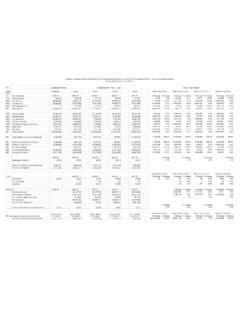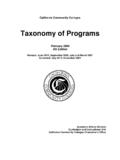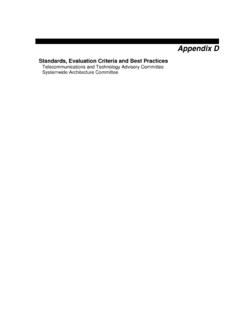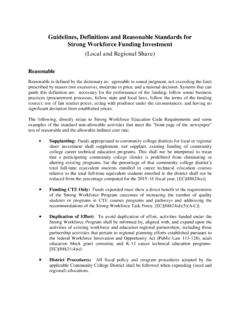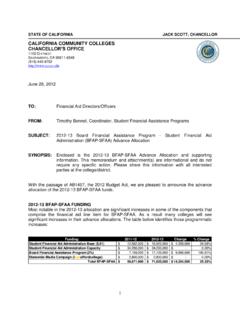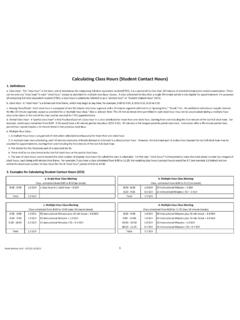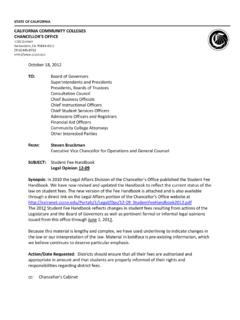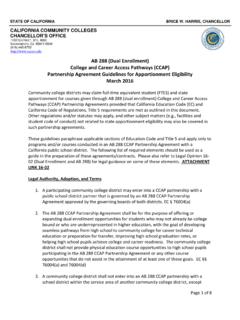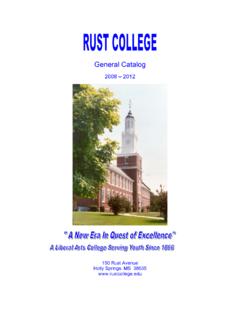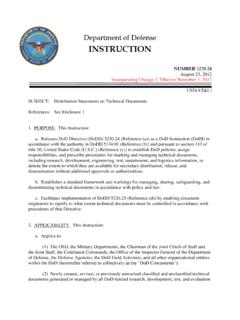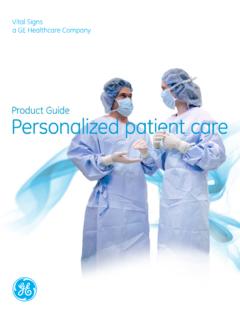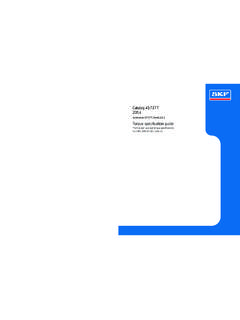Transcription of Open-Ffe - System Operations
1 Open-Ffe THE DIVISION OF ACADEMIC AFFAIRS. Program and Course Approval Handbook 6 Edition th CALIFORNIA COMMUNITY COLLEGES CHANCELLOR'S OFFICE. Eloy Ortiz Oakley, Chancellor July 2017. Program and Course Approval Handbook Page 1. The PCAH is dedicated to Randal L. Lawson, beloved colleague and friend. TABLE OF CONTENTS. PART I: OVERVIEW OF CURRICULUM AUTHORITY AND APPROVAL. Section 1: An Overview of Program and Course Approval 6. Part I: An Overview of Program and Course Approval 8. Part II: Credit Curriculum 8. Part III: Noncredit Curriculum 9. Section 2: Introduction to Program and Course Approval 10. A. History and Legal Authority for Curriculum 12. B. Development Criteria 14.
2 C. open Courses 19. D. Curriculum Regulations 20. PART II: CREDIT CURRICULUM. Section 1: Introduction to Credit Course Criteria and Standards 25. I. Credit Course Criteria 26. A. Criteria for Credit Course Submissions 27. B. Criteria for Data Elements 27. C. Criteria for the Course Outline of Record 31. Section 2: Credit Course Criteria and Standards II. Credit Course Standards 34. A. The Course Outline of Record 36. B. Course Types and Definitions 37. 1. Program Applicable (in an approved program) 37. 2. Degree-Applicable 38. 3. Nondegree-applicable 38. 4. Stand-Alone 39. C. Standards for Approval 40. 1. Associate Degree-applicable Credit Courses 41. 2. Nondegree-applicable Credit Courses 43.
3 D. Standards for Credit Hour Calculations 44. 1. Standard Formula 44. 2. Fractional Unit Awards and Minimum Thresholds 48. 3. Cooperative Work Experience Formula 49. 4. Clock Hour Programs 49. 5. Local Policy 49. 6. open Entry/ open Exit Course Credit Calculations 50. Program and Course Approval Handbook Page 2. E. Other Course Types and Standards 50. 1. Standards for Conditions on Enrollment 50. 2. Credit Course Repetition 51. 3. Standards for Distance Education 53. 4. Standards for open Entry/ open Exit Courses 53. 5. Cooperative Work Experience Education 54. 6. Independent Study Courses 56. 7. Educational Assistance Class Instruction (Approved Special Class) 57. 8.
4 Apprenticeships 58. 9. Contract Education 59. Section 3: Credit Course Program and Standards 62. I. Overview of Credit Programs 65. A. Program Types 65. B. General Associate Degree Standards 66. C. Standards for Writing and Computation Competency 66. II. Associate Degree for Transfer Degrees: AA-T and AS-T 67. A. Degree Standards 68. 1. Minimum Units 68. 2. Major or Area of Emphasis: Transfer Model Curriculum 68. 3. General Education 69. 4. Electives 70. 5. Prohibited Practices 70. B. Criteria for Approval 70. 1. Program Narrative 70. 2. Chancellor's Office Templates for Transfer Model Curriculum 71. 3. Course Identification Numbering System or ASSIST Documentation 71.
5 C. Double Counting Procedures for General Education 72. III. Career Technical Education Degrees: AA and AS 72. A. Degree Standards 72. 1. Minimum Units 73. 2. Major or Area of Emphasis 73. 3. General Education 74. 4. Electives and Local Graduation Requirements 75. B. Criteria for Approval 75. 1. Program Narrative 76. 2. Required Documentation 76. Program and Course Approval Handbook Page 3. IV. Local Associate Degrees: AA and AS 77. A. Degree Standards 78. 1. Minimum Units 78. 2. Major or Area of Emphasis 78. 3. General Education 79. 4. Electives and Local Graduation Requirements 81. B. Criteria for Approval 81. 1. Program Narrative 81. 2. Other Documentation 82. V.
6 Certificates of Achievement 83. A. Standards and Definition 83. 1. Unit Thresholds and Requirements 83. 2. Sequence of Courses 83. 3. Certificates in California State University General Education Breadth and Intersegmental GE Transfer Curriculum or Adjacent State Transfer Pattern 84. B. Criteria for Approval 84. 1. Narrative 85. 2. Career Technical Education Certificates Additional Documentation 85. 3. Local (non-CTE) Certificates Additional Documentation 85. VI. Collaborative Programs 86. VII. Labor Market Information and Analysis 86. PART III: NONCREDIT CURRICULUM. Section 1: Introduction to Noncredit Program and Course Approval 90. A. History and Philosophy 91. B.
7 Legal Authority 92. C. Development Criteria 94. D. open Courses 94. E. Noncredit Curriculum Regulations 96. Section 2: Noncredit Course Criteria and Standards 99. I. Noncredit Course Criteria 100. A. Noncredit Categories 101. B. Criteria for Data Elements 104. Program and Course Approval Handbook Page 4. II. Noncredit Course Standards 109. A. The Course Outline of Record for Noncredit Courses 109. B. Standards for Approval of Noncredit Curriculum 110. C. Other Topics and Standards in Noncredit Courses 111. 1. Conduct of Noncredit Courses 111. 2. Repetition and Noncredit Courses 112. 3. Grading Policy for Noncredit Courses 112. 4. Acceptance of Noncredit Courses towards Requirements for an Associate Degree 112.
8 5. Apportionment and Noncredit Courses 112. 6. Noncredit and FTES and Computation of Enrollment 113. 7. Noncredit Distance Education 113. 8. Noncredit Apprenticeship Courses 114. 9. Standards for open Entry/ open Exit Noncredit 115. 10. Noncredit Tutoring 115. Section 3: Noncredit Program Criteria and Standards 116. A. Definitions of Noncredit Programs and Award Types 118. B. Noncredit Program Approval 118. C. Noncredit and Career Development and College Preparation 119. 1. Certificate of Competency 120. 2. Certificate of Completion 120. D. Adult High School Diploma 120. E. Noncredit Apprenticeship Programs 121. F. Locally Approved Programs 122. Program and Course Approval Handbook Page 5.
9 PART I: OVERVIEW OF CURRICULUM AUTHORITY AND APPROVAL. SECTION 1: AN OVERVIEW OF PROGRAM AND. COURSE APPROVAL. Program and Course Approval Handbook Page 6. SECTION 1. AN OVERVIEW OF PROGRAM AND COURSE APPROVAL. OVERVIEW. This section provides an overview of program and course approval and identifies portions of the Handbook relevant to credit and noncredit curriculum. Credit Curriculum Noncredit Curriculum Program and Course Approval Handbook Page 7. OVERVIEW OF CURRICULUM AUTHORITY AND APPROVAL. Section 1: An Overview of Program and Course Approval This Program and Course Approval Handbook (PCAH) assists California Community College (CCC). administrators, faculty, and staff in the development of programs and courses and the submission of these proposals for review by the Chancellor's Office.
10 By law, the Chancellor is required to prepare and distribute a handbook for program and course approval (Cal. Code Regs., tit 5, ). The Chancellor has delegated these responsibilities to the Academic Affairs Division of the Chancellor's Office. The PCAH was developed to provide the CCC System with general guidelines and instructions for the submission of curriculum for approval and maintenance. Since the first publication, updates have been published May 1985, July 1987, 1992, March 1995, September 2001, March 2003, March 2009, September 2012, and July 2017, to improve and incorporate new information, clarify previous language, and inform and provide guidance on updates to California Education Code and California Code of Regulations, title 5.
